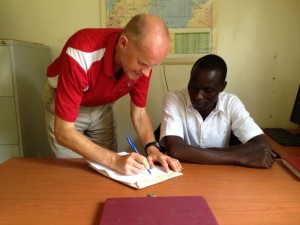I moved to Lubbock, Texas four years ago for my husband to attend Texas Tech University’s MD/MBA program. Having never lived outside of Utah before (with the exception of an LDS mission to New England for 18 months), I wasn’t sure what to expect when I got to Lubbock. I was a stay-at-home mom of two little kids under age 2 and I was very physically active in the beautiful community that I came from, St. George, Utah.
My first week in Lubbock, I ran in a community 5k and met some wonderful people. They all seemed to belong to the same running club; the West Texas Running Club. I decided to give this new club a try and showed up the following week for a training run. I made many incredible friends that I have since gotten to know really well over a lot of miles, laughs and races, including Jerry Dwyer.
Meeting Jerry is like meeting an encyclopedia of running! He really knows his stuff and he has become not only my mentor/coach but also many other runners in the group, helping them to achieve their goals. I am currently working with him with the goal to qualify for Boston at the 2016 Ogden Marathon (more on this later). Jerry was kind enough to share some nuggets of wisdom with all of us here at MarathonMomma.com. So here you go!
Jerry Dwyer is a runner and an academic. He grew up in Ireland and played many sports and studied math. He is now a professor of mathematics at Texas Tech University and he has run about 30 marathons. He has no formal coaching experience, but is one of the best coaches I have ever met. He listens to and reads everything he can find on the subject, and his years of study are impressive and apparent. He likes to encourage and give advice to runners and finds great reward in seeing runners like me make progress in our training.
Enter Jerry
I am not a mother but I hope I can share some common principles that apply to all runners. This blog focuses on moderation and how that is best for you. That is something that should appeal to all marathon mommas who have busy lives and need to realize that progress can be steady and will continue even if you miss some training or can’t find the time for an intense session.
The following reflections on aspects of running and training have been gathered over at least 30 years of experience. These are issues don’t often appear explicitly in training plans or magazines although they are occasionally referenced.
Distance Running is a Long-term Process
Great gains can be made in a few weeks or in a four-month buildup to a marathon. But real success takes at least two years of slowly building a base, followed by some speed work, and then specific tuning for the target race distance. That also means that any single session isn’t important. It is the accumulation of sessions over many months that make the difference.
Maximal Training vs Optimal Training
A related point is to recognize the difference between maximal training and optimal training. I could assign an intense speed work plan that gets you a 30 second PR in the 5K with about 6 weeks of training. You could peak for that 5K. That is maximal training. But that training has maximized your potential in 8 weeks and training stalls after the race. After some recovery time you may return to train for another 5K and the same training will get you the same race result. Many runners repeat this kind of process over several years.
An alternative is to continue to build a base of easy running and assign a less intense speed work plan that may only result in a 10 second PR. But that training leaves you fresh enough to continue a small amount of speed work for many months after the race and gain new PR’s of 10 seconds every four months or so. After two to three years there may be a 60 seconds gain in 5K times. That is optimal training!
Weight Training
I have noticed this difference in training most clearly when doing weight training in the past. I may begin bench presses at 100 lbs and add 10 lbs per week for about 4 weeks, finding increased strength and power. Then suddenly I find the 140 lbs gets more difficult and after another week the previous 130 lbs is difficult. I have trained maximally and made a short term gain without allowing proper time for adaptation. On the other hand I should have trained optimally by staying at the 100 lbs for about three weeks and then added the 10 lbs. After about 12 weeks I will have reached the 140 lbs and I will be strong enough to handle it without crashing.
Don’t Let it Get Boring
This realization has helped me greatly in designing cross training routines that aren’t boring or self-defeating. I pick an exercise such as a push-up and start with something like two repetitions. This means no pretense that I am strong and ego has to be dismissed. The essential component is to have perfect form and to spend two to three weeks just perfecting that form. Then I can move to three repetitions. After another week or two I can move to four repetitions. That brings satisfaction that I am making progress. After about six to eight weeks there is a certain plateau effect. So then I move to a variation of the exercise. For example if I have mastered some regular push-ups, then I decide to begin again with push-ups with a wide arm stance. I start with two repetitions and go through the six-week process again while enjoying the progress made on the new exercise.
I apply that approach to almost my entire cross training and also to my stretching routines. There are endless variations so there is no boredom. There is the satisfaction of a small amount of progress every week. It is never dramatic but it is enough to stay motivated. I stumbled upon all of this through my own trial and error. But I believe there is actually some research, which shows that this type of approach is actually optimal for muscle development.
Biking
One area this is most useful is for my biking routines. An hour on the road or on a stationary bike can be boring but if it is broken up into specific segments it can be much more enjoyable. Spend five minutes riding hard followed by recovery followed by five minutes standing followed by recovery etc. If good form is maintained then progress is made from five minutes to six to seven etc.
One Last Thought
My final point in favor of moderation relates to individual workouts. If a training plan is moderate and following an optimal approach then each workout should be manageable. However there are days when the session appears to be extra difficult. This may be due to insufficient recovery or poor eating in previous days. In those cases the workout should be reduced or postponed. The reason for this is that it is counterproductive to perform a workout that is too difficult. The key point I have learned over the years is that it is not about managing a workout with wonderful times. It is about running a workout from which the body adapts and improves. A session that is too difficult simply results in muscle breakdown rather than adaptation. It is not optimal training!
Share This:




Jerry helped me last January qualify for Boston! I am so glad I listened to his advice! Good luck to you with qualifying!